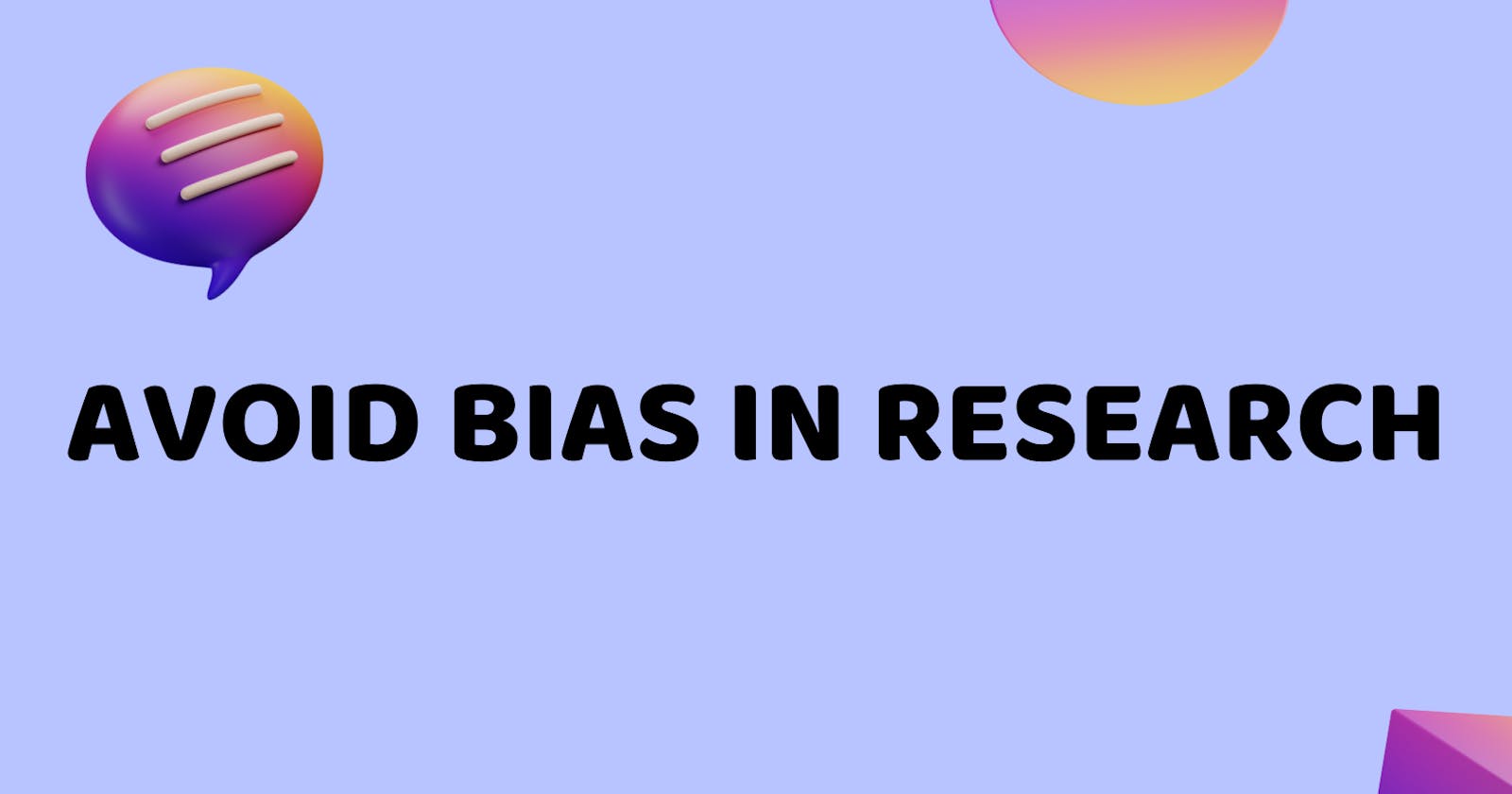In my previous blog, "What Is UX Design?" I addressed how avoiding biases in research is important. In this blog, I want to dig into that more and discuss different ways you can avoid them, and how learning the pain points of your users, and empathizing with them can help you create an even better product.
What is a "research study"?
In UX, a research study is a step-by-step examination of a group users and their needs. This helps UX Designers add context to the design process.
There is 4 steps to a research study. Those steps are:
Plan the study
Conduct the research
Analyze and synthesize the results
Share and promote the insights
Let me break each of these down individually so you can understand them before continuing.
Plan The Study
To conduct a successful research study, you want to start here. Without a plan, how can you get to the end goal? So start by outlining the background of the project you are working on. After that, you want to set goals. I always say, "without goals, what are you working towards?" With these goals, create questions focused around them to ask your participants. For example, if you are creating a fitness app for users to find workouts and track their food, you can ask them what features they are missing from an app they are currently using that they wish would be available. Maybe they would like to have a way to view live workout times and join in on live streams similar to the Peloton app.
Conduct The Research
During this next step, you will gather all of the data. There are many ways you can do this but a big one is a usability study. A usability study is a type of research method used that will assess how easy or difficult it is for users to complete tasks in a design. You want to find pain points that a user may experience with a design so these can be addressed and fixed before you hand off the final product to the engineering team. You can conduct as many usability studies as you need!
Analyze & Synthesize Results
This is a crucial part of your entire research study. Why? Well, you want to find out why the data you collected looks the way it is. Are there any patterns/trends in the study participants? Are there any that specifically stands out to you?
Share & Promote Your Insights With Project Stakeholders
If you're new to this, you may be wondering who are the project stakeholders? These people are involved in the project or will be impacted by its final results. They need the results of your research study because they will want to review and agree on the direction of the project together. Again, this can affect them so you need to be attentive to their opinions as well.
During this stage, you will create a presentation and this will include the method you chose to use during your research study, such as if it was moderated or un-moderated study. Discuss the data you collected, the conclusions you decided based on the data, and any recommendations from the participants.
REMEMBER... the point of all of this (UX Research Studies), it helps you, the UX Designer, understand the user's problems so we can solve them. The user is our priority, right? Correct. We don't create products based on what the company thinks it needs, we create and base the products on our users wants.
Language & Communication Are Important During UX Research
We all should know this... communication is important for any type of relationship in life. I'm talking about friendships, family members, colleagues...etc. If we don't express what we are feeling or what is going on, how will the other person know? We sure aren't mind readers! During UX Research, you will be communicating with all different types of people so you will need to understand the roles language and communication play, so let's dig in.
Tone & Choice Of Words
Your tone and the words you choose while speaking can determine how a conversation will go. Ever hear or have said the phrase, "Don't shoot the messenger"? Do you know what that is from? I'm sure you can take a wild guess if you don't. It dates back to before telephones and instant messaging when messages were actually delivered via human envoys. During the wars, a messenger would be sent from one of the camps to another and if the message upsets the other camp, those receivers might blame that messenger for the bad news and take their anger on them. Don't blame the poor messenger!
How about if you are emailing or texting someone... have you ever read a message and didn't know how to take it? Maybe you read it as the person being standoffish but they weren't. This is because the message lacked tone. So if you are unsure about the tone of a message you received, just call that person.
Language Matters
Just as I stated above, written and spoken language plays a major role in the success of your product and the feedback you will receive about your designs which can affect the final product. While conducting a study, make sure to build a relationship with the participant. Make them feel comfortable and not under pressure. The language you use will affect the language your participants use. Let me break that down into an example. Let's say you walk into an interview, all dressed up, got your hard copy resume, all cleaned up, feeling good about yourself...right? When you walk in the interviewee is very enthusiastic, loud (but a good type of loud, not obnoxious), and "cheery". You might've been expecting them to not be like that. You were prepared to be more formal. Their energy and language will affect yours. You're not going to be formally speaking to them as they are in a more enthusiastic language right!? No. This goes vice versa as well!
Another thing I believe is important during the interview process. If the demographic of the study participants is young adults, around 18 - 25, the interviewee should be someone close in age. This way they may know the "popular language" being used during that time. There are always new terms bouncing around that younger generations are using. Using these terms may make that participant feel more comfortable. Keep it professional but help connect with your participant on a more personal level.
Identify Biases While Interviewing Study Participants
It's important to understand this, all humans are susceptible to having a bias. Even you, the person reading this. But if you want to become a successful UX Researcher, you will need to become aware of these biases so you can stay away from them and not let them show, especially during a usability study. You may not even realize you are biased toward something so let's discuss a couple of common biases you may have during your studies.
Implicit Bias
Also known as unconscious bias, is the collection of different attitudes and stereotypes we connect to people without us acknowledging it. These are most of the time negative. If you have an implicit bias towards a certain group you choose for your study, this bias will impact your expectations for those participants and how they will view and interact with the product.
Serial Position Effect
This is a type of psychological bias that will state the given list of items. When you give people that list, they are more likely to remember the first few and last few items but the middle items will tend to be a blur to them. So you need to be careful while interviewing participants because this serial position effect can occur.
Friendliness Bias
This is the tendency that people tend to agree with those they like so they can avoid confrontation in their conversations and maintain that friendship. So think of this bias like this... for example, if you are hanging out with a friend and they ask you, "do you like Korean food?" and you don't like it but you say yes to avoid confrontation? This is a prime example of this. So if you are running a usability study, being too friendly and building too strong of a rapport with participants, there is a major chance they will tend to agree with whatever you say to avoid confrontation with you. This will stop them from giving honest feedback on the product.
Social Desirability Bias
This is a type of bias that is described as the tendency for people to answer a set of questions in a way that will be viewed as favorable by others. Here is an example of this... if you are hanging with a group of friends and you all go out to the bars and it's now midnight. They all decide they want to go to the next bar down the road and you are ready to go home but you say yes to staying out to be viewed favorably by the group even if you didn't actually want to stay out. This can really affect your usability studies because it can cause participants to focus only on the positive aspects and not focus on the negative aspects.
Conclusion On The UX Research Design Process And Biases
UX Designers and Researchers always need to make sure they are aware of their biases. Remember, keep in mind the user is the center of our entire product. With no user, there is no product. And with no studies, there is no knowing if the product needs to be fixed or not. UX Research is the biggest crucial step of any product, so make sure you are prepared for your next usability study!

